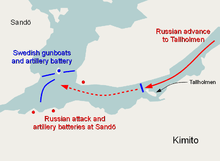Battle of Sandöström
| Battle of Sandöström | |||||||
|---|---|---|---|---|---|---|---|
| Part of Finnish War | |||||||
| |||||||
| Belligerents | |||||||
|
|
| ||||||
| Commanders and leaders | |||||||
|
Rear Admiral Klas Hjelmstjerna Lieutenant Colonel Önnert Jönsson Captain Sölfverarm |
Captain 1st class Hayden Lt. Captain Dodt | ||||||
| Strength | |||||||
| 22 Gun sloops |
| ||||||
| Casualties and losses | |||||||
|
| ||||||
The Battle of Sandöström was fought between Sweden and Russia during the Finnish War 1808-09.
Prelude
After failing to destroy the Russian coastal units near Turku Swedes chose to attempt to destroy the Russian reinforcements. As Swedish fleet controlled the open sea were the Russian coastal units forced to use narrow coastal waterways and so Swedes deployed detachment of gun sloops under Captain Sölfverarm to block the passage north of island of Kimito by the small island of Tallholmen.[1]
Hjelmstjerna was forced to split his forces to prevent Russian coastal forces from Turku from getting into his rear and therefore he initially gave Sölfverarm only 8 gun sloops but later reinforced them with further four. He retained 14 gun sloops and 7 galleys for himself and posted 4 additional gun sloops to block other coastal waterways. Sölfverarm was aware of the weaknesses of his position and started blockading the waterways.[1]
First attempt to breach Sölfverarm position happened on 18 July when 6 Russian gun sloops tried to get past the Swedes without success and has become known as the battle of Tallholmen. Under command of Captain 1st class Hayden did Russian detachment of 30 gun yawls make the next attempt with the support of Russian artillery batteries and ground forces on the shore on 21 July slightly after midnight. Though greatly outnumbered the Swedes managed to make an orderly withdrawal. Neither side managed to sink any ships however Swedes suffered casualties of 46 dead and wounded against Russians 19, though Russian commander Hayden was amongst the badly wounded.[1]

Sölfverarm continued to strengthen his defenses and constructed artillery battery to an island in middle of the narrow passage. Swedes were also reinforced with Lieutenant Colonel Önnert Jönsson - who took command - and with 10 gun sloops. Also Russians gained reinforcements and now were able to field 50 gun armed vessels. In addition to naval assets Russians had one six gun and 1 four gun batteries, 2 field guns and six companies of infantry in support.[2]
Russian attack started on 2 August at 0300. Swedish battery in the middle of the passage proved to be very effective though it also was subjected to heavy fire. Though several Swedish gun sloops were forced to withdraw from the battle line Swedes managed to beat back the initial Russian attack. More attacks followed during the day but Swedes were able to hold their line. However, later a stronger Russian attack managed to breach Swedish line and forced Swedish naval forces with withdraw leaving the artillery battery surrounded by Russians.[2]
Swedish withdrawal was orderly and Russians failed to take advantage of it before Hjelmstjerna's reserves arrived. However instead of counterattacking with fresh forces against Russians who had expended most of their ammo he chose to withdraw. Though battle itself was not a clear victory either way Russians managed to gain access through the coastal waterways and link up with their coastal units.[2]
Aftermath
While the naval battle was being fought at Sändöström another Swedish unit was performing landing operations on the island of Kemiö. As the landing operation suffered from multiple delays the initial goal of the operation, to provide support for preventing Russian ships from getting past Kemiö, failed but after learning that Russian commander of operations in Finland Friedrich Wilhelm von Buxhoeveden was dining at nearby manor house of Vestankärr decided Colonel Axel af Pàlen, commander of the landing force, to attempt capturing him.[3]
Af Pàlen managed to reach the vicinity of the manor house with his 150 men without being seen but while Swedes were moving in to surround the house the Russian pickets saw him and alerted their commander who managed to escape. Arriving Russian reinforcements forced the landing force to retire.[3]
References
- 1 2 3 Mattila (1983) p.270-272
- 1 2 3 Mattila (1983) p.272-275
- 1 2 Mattila (1983) p.275-276
Bibliography
- Mattila, Tapani (1983). Meri maamme turvana [Sea safeguarding our country] (in Finnish). Jyväskylä: K. J. Gummerus Osakeyhtiö. ISBN 951-99487-0-8.
- Lars Ericson Wolke, Martin Hårdstedt, Medströms Bokförlag (2009). Svenska sjöslag